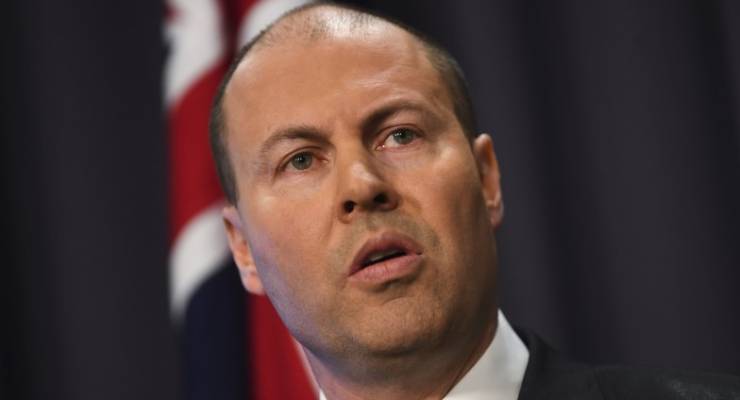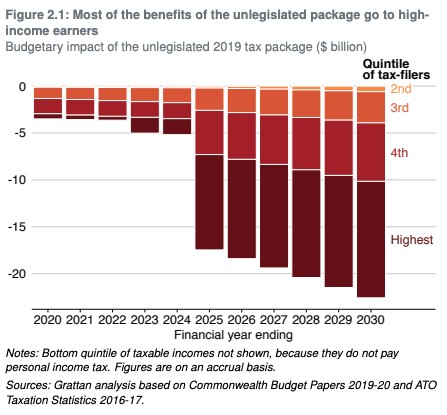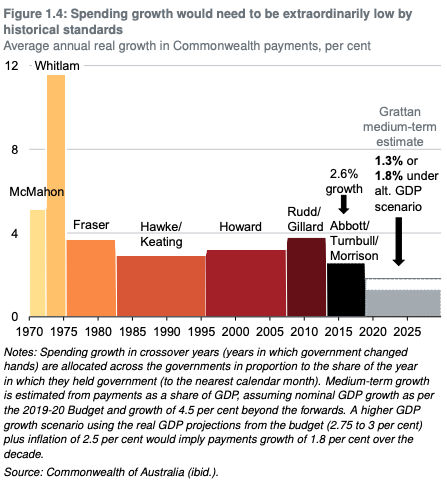
Remember when Bill Shorten was being pressed during the election campaign about the economic costs of his climate change policies? No such scrutiny was applied by journalists to the costs of one of the few policies Scott Morrison actually took to the election, his three-stage tax cut plan stretching half a decade into the future — probably because since Morrison was going to lose, his policies didn’t need aggressive interrogation (or the journalists just worked for News Corp).
That was even the case after Grattan Institute pointed out, in a preliminary analysis of the government’s tax cut package, that the new, unlegislated component of stage three of the tax cuts would require spending cuts worth tens of billions of dollars if the budget wasn’t to go back into deficit.
Now the Grattan Institute has taken a more detailed look at the tax cuts and the outcome is very different to the “modelling” being peddled by some media outlets to support the passage of the unlegislated portions of the package through parliament. The report urges the passage of legislation to complete stage one of the cuts to provide immediate stimulus, given how weak the economy is. It is agnostic on stage three of the cuts, noting that they “do not come into effect until 2022-23 so are not as well timed to provide stimulus. But the unlegislated component is relatively small and does not raise the same significant concerns that apply to Stage 3.”
However, the $85 billion unlegislated portion of the stage three cuts will disproportionately flow to high income earners, will increase inequality and assume a level of spending restraint unprecedented in the modern economic era.
The report makes clear that stage three will provide a windfall for people on high incomes:
Half of the unlegislated changes, and two-thirds of the unlegislated Stage 3 cuts, flow to the top 20 per cent of tax-filers. This comes in addition to the Stage 3 tax cuts that are already legislated and due to come into effect in July 2024.

The package only partly addresses bracket creep for low and middle-income earners, noting that someone “in the middle of the income distribution would have an average tax rate 3.7% higher in 2029-30 than they do today, instead of 5.2% higher under current legislation and 6.1% higher with no plan at all”.
But it’s a better story for high income earners, who “will actually be over-compensated for bracket creep. Under the government’s plan, the top 15% of income earners will have an average tax rate 1% lower than they do today …”
So with high income earners getting a net benefit overall, the income tax system will be made markedly less progressive. Indeed, “the Government’s plan will result in the personal income tax being less progressive than it’s been at any time since the 1950s”.
But don’t tax cuts for the rich encourage them to work harder and earn more? Hmmm, not so fast.
The group most responsive to effective tax rates in work decisions are second-earners (mainly women) working part-time.
Tax cuts and transfer reforms targeting them are more likely to incentivise greater earning than handouts to high income earners.
Long historical records also have to be employed to illustrate how unlikely it is that the government will be able to fund the mammoth cost of stage three from spending cuts alone. To fund the cuts, no new spending will be possible over the coming decade. This “will require unprecedented restraint. Real spending growth would need to average around 1.3% per annum over the decade — or 1.8% if the economy performs as strongly as Treasury projects. Either way, this is substantially lower than any previous government has achieved.”
No government as far back as the 1960s has managed the kind of restraint the tax cuts assume.

Of course, there’s a term for this approach to fiscal policy. Republicans in the US call it “starve the beast” — cut taxes without identifying how they’ll be paid for and let the resulting deficits pressure future governments into cutting back on spending. It’s an effective way to transfer wealth from recipients of government spending — low and middle income earners — to high income earners, without the losers noticing.
Or, in this case, much of the media.








Correction to the third paragraph, I think it should read :”The Stage 2 cuts do not come into effect until 2022-23 so are not as well timed to provide stimulus.”
Tax cuts are extremely slow in their ability to generate s stimulus.
Turkeys voting for xmas is the only logic behind the stupid voters re electing scummo and his mob, now maybe 3 years of suffering and increasing poverty may jolt the dumb fools back into reality.
It’s questionable whether the stage 1 or 2 tax cuts will have enough impact to jolt the economy but one thing is for sure…stage 3 will definitely not. Couple this with the bedding down of the removal of weekend penalty rates for those on lower incomes and you have a handout with absolutely no rational at all.
This looks for all the world like the continuation upwards in the pay-scale of Howards middle class welfare.
Seems obvious that the plan is to induce mass poverty. For what purpose I wonder. Are we expecting another world war when men joined up to just get a pay packet? Or do all the landed gentry need downstairs staff? I’m sick of all this BS about the wealthy and the great trickle down nonsense. If that worked we’d be seeing the benefits long before now.
Another monumental failure by our media – serving their own ends, peddling their own politics, editing news, to their own ends – getting in our way of finding out what’s happening (before we vote) – rather than serving society’s interest.
Meanwhile, elsewhere :-
* O’Brien’s warning at the Logies,
* Gleeson’s treatment of the media (and the subsequent votes), and
* Miller whining about “freedom of the press” – to do what? Ignore reality? To use their elite privileged positions to play favourites, to run protection rackets from scrutiny, to benefit the electoral chances of their preferred party?
Often BK et al use this clunky, phrase “…three-stage tax cut plan stretching half a decade into the future..” rather than 5 years? Faux scary?
The ramifications of the tax package are bad enough without vorpal blades.
Also, the wind-up “It’s an effective way to transfer wealth from recipients of government spending — low and middle income earners — to high income earners, without the losers noticing.” is a bit of a stretch – the losers certainly will notice but will be told that it’s the fault of the usual suspects, dole bludgers, boat people, those with a tendency to melanin etc.
And, as previously & most recently, they will believe it.